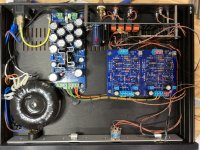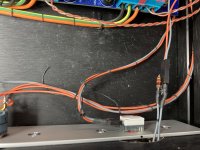Hi friends
I just got impressed by both the documentation of the (Aussie) Advisory Circular AC AIRCRAFT WIRING AND BONDING ...
and the bespoke audio passive preamp...
and thought that I should/could do that too. 😀
What thread/string can be used to get there? It seems like it's a bit a specialty material, can it be substituted?
Yes of course I could just try'n err, but probably there's somebody more experienced willing to share a bit of knowledge?
Thanks
david
I just got impressed by both the documentation of the (Aussie) Advisory Circular AC AIRCRAFT WIRING AND BONDING ...
and the bespoke audio passive preamp...
and thought that I should/could do that too. 😀

What thread/string can be used to get there? It seems like it's a bit a specialty material, can it be substituted?
Yes of course I could just try'n err, but probably there's somebody more experienced willing to share a bit of knowledge?
Thanks
david
Your Australian link is for military grade RF cable which would be (usually ) 50 ohms impedance it is manufactured to a high standard so that their are no "reflections " that bring down the bandwidth of the cable and that includes precision machine manufactured .
Even the termination /insulation /mesh insulation are of a special and high standard .
As someone who set up analogue TV transmission cable for outside broadcast while working for BT bunched pairs of twisted cable were used to keep the video signal at a high enough frequency for transmission and using top quality satellite cable for my own large dishes I can assure you cheap homemade stuff doesn't cut it neither does all those cheap brands on the market .
I admire your willingness to try -good on you but this is an area where high quality reigns supreme using cheap /low grade stuff causes all sorts of cable problems .
Thinking -oh its only a connecting cable wont work when you want the quality you want from DIY .
There are plenty of books on cable theory and practice .
If it were just standard low frequency ( audio ) cable then go ahead but you want the engineering quality used by the military/aircraft industry and yes I worked for HA in Kingston -on -Thames for a while and they used very high grade cable with special machine terminations in the P1127 at the time I worked there.
Even the termination /insulation /mesh insulation are of a special and high standard .
As someone who set up analogue TV transmission cable for outside broadcast while working for BT bunched pairs of twisted cable were used to keep the video signal at a high enough frequency for transmission and using top quality satellite cable for my own large dishes I can assure you cheap homemade stuff doesn't cut it neither does all those cheap brands on the market .
I admire your willingness to try -good on you but this is an area where high quality reigns supreme using cheap /low grade stuff causes all sorts of cable problems .
Thinking -oh its only a connecting cable wont work when you want the quality you want from DIY .
There are plenty of books on cable theory and practice .
If it were just standard low frequency ( audio ) cable then go ahead but you want the engineering quality used by the military/aircraft industry and yes I worked for HA in Kingston -on -Thames for a while and they used very high grade cable with special machine terminations in the P1127 at the time I worked there.
Thank you, Duncan, too
Well, being nearly ignorant on that matter, I'll never be able to cope with the real thing. All I want is some good looking, good sounding gear. So, although I know the aircraft-tech is as unreachable to me as is the _science_ of electronics, I still try to avoid the crap-stuff... just trying to replicate things [emoji56][emoji1308]
Well, being nearly ignorant on that matter, I'll never be able to cope with the real thing. All I want is some good looking, good sounding gear. So, although I know the aircraft-tech is as unreachable to me as is the _science_ of electronics, I still try to avoid the crap-stuff... just trying to replicate things [emoji56][emoji1308]
Any waxed thread will do the job pretty much. I've a fondness for spirawrap for tidying harnesses as its easily removable when you need to replace or add a wire, and it can be twisted on rapidly.
yes, spirawrap is an easy, very pragmatic solution.
I'll still try the classic method, just to see. (My motivation to dive into it was that I don't like the bulky knot of the classic cable ties)
I'll still try the classic method, just to see. (My motivation to dive into it was that I don't like the bulky knot of the classic cable ties)
the local surplus shop has:
GUDEBROD - WMLTAA52080-A-5 -
Cordage, lacing. Reel, 500 yards 20-125 Mil. Material: Polyamide nylon, MIL-T-43435, type 1 overall. Breaking strength: 15.0 pounds minimum. Color: natural. Note: Alt P/N: A-A-52080-A-5.
$39.99
GUDEBROD - WMLTAA52080-A-5 -
Cordage, lacing. Reel, 500 yards 20-125 Mil. Material: Polyamide nylon, MIL-T-43435, type 1 overall. Breaking strength: 15.0 pounds minimum. Color: natural. Note: Alt P/N: A-A-52080-A-5.
$39.99
thanks speedskater!
I doubt they'd post to switzerland [emoji6]
Heck and I‘d need what, 6-10 ft of it?
My dream must go on...
(I might try with a waxed yarn just to practice...)
I doubt they'd post to switzerland [emoji6]
Heck and I‘d need what, 6-10 ft of it?
My dream must go on...
(I might try with a waxed yarn just to practice...)
Electrical lacing cord is what I use.
Lacing cables used to be highly thought of but it also can introduce magnetic coupling between wires.
A speaker wire next to an input wire might not be good.
I still do it but take care what is in each bundle.
Lacing cables used to be highly thought of but it also can introduce magnetic coupling between wires.
A speaker wire next to an input wire might not be good.
I still do it but take care what is in each bundle.
Last edited:
Years ago I worked for the provincial phone company, in the pre-digital days, the switching offices were, obviously, full of wire bundles snaking everywhere. And they were all neatly tied, with a running stitch (for lack of a better term) with waxed line. The benefit of the wax was that it would hold, long enough, when pulled tight to allow the next loop to be formed.
Any monofilament fishing line works.
Or shoe grade polyester thread, thick enough for stitching shoes, or a close enough in thickness synthetic thread, cotton breaks after some years.
Try a local shop for stitching materials, or get thin twine from a hardware center.
One wire from the four in old keyboards or mice, or a single wire from a bad flat hard disk cable will work too.
Stay away from bare contacts if you use insulated wire.
Single strand insulated wire salvaged from indoor telephone installations, RJ45 cables, they all will do.
Or shoe grade polyester thread, thick enough for stitching shoes, or a close enough in thickness synthetic thread, cotton breaks after some years.
Try a local shop for stitching materials, or get thin twine from a hardware center.
One wire from the four in old keyboards or mice, or a single wire from a bad flat hard disk cable will work too.
Stay away from bare contacts if you use insulated wire.
Single strand insulated wire salvaged from indoor telephone installations, RJ45 cables, they all will do.
just to confirm this thread wasn't for nothing: I experimented a bit with harnessing wires, using dental floss and also a fat (unwaxed) cotton-thread.
whatever thread you use, it seems important to have it waxed because if not the thread tends to slip and the knots to loosen…
This detail put aside, making a harness is really easy, all it takes is that little bit of patience.
The knots, as recommended by the official build-guide, while looking complicated, are the easiest imaginable.
Having those wire-runs grouped is really really helpful in keeping a chassis’s interior free from rats nests. (Other things, like proper arrangement and wire-diameters, matter even more, of course)
whatever thread you use, it seems important to have it waxed because if not the thread tends to slip and the knots to loosen…
This detail put aside, making a harness is really easy, all it takes is that little bit of patience.
The knots, as recommended by the official build-guide, while looking complicated, are the easiest imaginable.
Having those wire-runs grouped is really really helpful in keeping a chassis’s interior free from rats nests. (Other things, like proper arrangement and wire-diameters, matter even more, of course)
Attachments
Last edited:
Thank you!
The next skill I will train myself is how to clean a chassis before making a foto 😀
(ahem, no, I shall rather refine the art of making harnesses and improve chassis-layout-techniques...)
The next skill I will train myself is how to clean a chassis before making a foto 😀
(ahem, no, I shall rather refine the art of making harnesses and improve chassis-layout-techniques...)
Looks better than zip ties 😉
With the waxed aircraft lacing cord, I usually touch the last knot of each run with the soldering iron to melt the wax and make the knot permanent.
CASA AC21-99 is a pretty comprehensive guide for wiring and bonding, and definitely worth the time to read through.
With the waxed aircraft lacing cord, I usually touch the last knot of each run with the soldering iron to melt the wax and make the knot permanent.
CASA AC21-99 is a pretty comprehensive guide for wiring and bonding, and definitely worth the time to read through.
Last edited:
Looks better than zip ties 😉
waxed aircraft lacing cord
CASA AC21-99
Yes, disliking those zip-cords was the reason I got into it, despite my knack for outlandish handcrafts… the original lacing cord only is available by the (multi-)kilometers, thus my quest for altenatives, but the manual is my reference too 🙂
Now I'm looking for places where I could make some wire-harnesses 😀
Search "leather crafts" on eBay(or elsewhere) for "waxed nylon thread" and you'll see a choice of colors, and it's very inexpensive.
- Home
- Design & Build
- Construction Tips
- What thread to use for wire harnesses?

